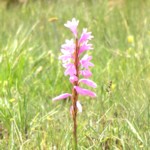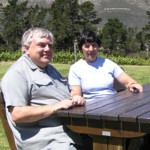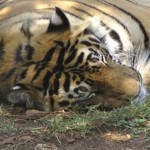
Arrival in Johannesburg
We had a day's rest in  Rutland House in Johannesburg on arrival, where Delia Ferguson made us very comfortable.
Rutland House in Johannesburg on arrival, where Delia Ferguson made us very comfortable.
We visited Soweto  and met James's cousin Wendy and her daughter Lulu.
and met James's cousin Wendy and her daughter Lulu.
James had not seen Wendy  for nearly forty years.
for nearly forty years.
Madikwe Game Reserve
 The following day we flew
to a bush airstrip in the Madikwe Game Reserve
where we stayed at Rhulani Lodge.
The following day we flew
to a bush airstrip in the Madikwe Game Reserve
where we stayed at Rhulani Lodge.


 Madikwe is on the South African side of the Botswana border, close to Gabarone.
There followed three days of four hour morning and evening game drives
in an open Land Rover with a sunshade, driven by Ranger Etienne with a
(legally required) rifle, which was never necessary, nor likely to be as
the big predators mostly ignore the Land Rovers, even when they are very close to them.
Madikwe is on the South African side of the Botswana border, close to Gabarone.
There followed three days of four hour morning and evening game drives
in an open Land Rover with a sunshade, driven by Ranger Etienne with a
(legally required) rifle, which was never necessary, nor likely to be as
the big predators mostly ignore the Land Rovers, even when they are very close to them.
We saw all of the "Big Five" -
Two Leopards, one male and one female twenty minutes apart
[some people safari for years and never see one leopard], and a herd of Buffalo
but these were all after sunset when it was too dark to photograph them.
 An Elephant
(and some others taking a dustbath in the ashes from a bush fire)
An Elephant
(and some others taking a dustbath in the ashes from a bush fire)


 Lions and their kills
Lions and their kills


(Both kills are wildebeest - the crow in the second picture is sitting on the end of a rib - but we didn't see a
vulture birthday.)
And Rhinoceros 
We also saw Cheetah .jpg) and Wild Dog
and Wild Dog
 (15 puppies, taken in late twilight)
(15 puppies, taken in late twilight)
Both of these are endangered, hard to find and even harder to photograph in the wild.
Of course we photographed many of the usual suspects as well:-
Zebra  Giraffe
Giraffe  Impala
Impala 

 Springbok, Kudu
Springbok, Kudu  and Blesbok
and Blesbok 
 Male and Female Nyala
Male and Female Nyala
 Eland
Eland 
Baboons 
 and Vervet Monkeys
and Vervet Monkeys

(only in Africa can there be traffic signs like this)

 Warthogs
Warthogs
 and Wildebeest
and Wildebeest 
by the Water Hole 
And a Wildebeest Leg  stolen by a Jackal from a Lion's kill.
stolen by a Jackal from a Lion's kill.
We are not avid birders and do not attempt to identify and photograph every LBJ ("Little Brown Job") that we encounter.
But we did see and photograph some attractive specimens, including
 Weaver Birds,
Ibis
Weaver Birds,
Ibis  Grey Lourie
Grey Lourie 
Lilac Breasted Roller 
 Hornbills
Hornbills

 Egyptian Geese &
a Glossy Starling
Egyptian Geese &
a Glossy Starling 
 Guinea Fowl
Guinea Fowl 
 And Ostriches
And Ostriches


Which we saw on farms, too, later in the trip.

When we first posted this page we had not identified the guys below and had them as
"a Big Brown Job and a wading Black & White Job"
Thanks to Lise Hagen and Katrina Knight we now have them identified as
 Swainson's Francolin and a Blacksmith Plover
Swainson's Francolin and a Blacksmith Plover

Of course we did not manage to photograph everything we saw.
And, as usual on safari, we had a lot of photos of bums, frequently disappearing into the bush.
(Note that these bumbnails are not hyperlinks to larger pictures.)
















Among the wild animals and birds we saw and did not photograph were
klipspringer,
hartebeest,
duiker,
jackal,
hyena,
spring hare, nightjar,
bush baby,
several species of eagle, buzzard and kite, and a bustard.

(This one IS a link.)
Drakensberg Mountains
After flying back to Johannesburg we drove to Kamberg in the Drakensberg Mountains in KwaZulu Natal and stayed for two days at the
Cleopatra Mountain Farmhouse

 The Cleopatra Mountain Farmhouse is beside a mountain dam less than 15 miles from the Lesotho border on the edge of the Natal Drakensberg Park
and is world-famous for its gourmet cuisine, beautiful surroundings and friendly dogs.
Thabo Mbeki, the President of South Africa, is a regular guest here
and the cooking really is fantastic - the set piece dinners are why one comes, but the breakfasts are also quite remarkable and deserve special mention!
The Cleopatra Mountain Farmhouse is beside a mountain dam less than 15 miles from the Lesotho border on the edge of the Natal Drakensberg Park
and is world-famous for its gourmet cuisine, beautiful surroundings and friendly dogs.
Thabo Mbeki, the President of South Africa, is a regular guest here
and the cooking really is fantastic - the set piece dinners are why one comes, but the breakfasts are also quite remarkable and deserve special mention!
The Cleopatra Mountain is so-called because it  is said to resemble Cleopatra's face in profile.
is said to resemble Cleopatra's face in profile.

 It is obvious why this peak is called the Giant's Castle. We visited the Giant's Castle Nature Reserve and the
Kamberg Rock Art Centre
where we saw baboons, eland, San rock art and innumerable mountain Spring flowers. Spring rain had been late and sparse when we arrived so the flowers
were only just starting to bloom, but they were everywhere.
It is obvious why this peak is called the Giant's Castle. We visited the Giant's Castle Nature Reserve and the
Kamberg Rock Art Centre
where we saw baboons, eland, San rock art and innumerable mountain Spring flowers. Spring rain had been late and sparse when we arrived so the flowers
were only just starting to bloom, but they were everywhere.




















Garden Route and Karoo Desert


 From the Drakensbergs we drove to Durban and flew to George on the "Garden Route" in the Western Cape where we rented another car
and drove to Knysna to stay at the historic Belvidere Manor,
another exceptional hotel - which stands beside the Knysna Lagoon.
From the Drakensbergs we drove to Durban and flew to George on the "Garden Route" in the Western Cape where we rented another car
and drove to Knysna to stay at the historic Belvidere Manor,
another exceptional hotel - which stands beside the Knysna Lagoon.



Knysna is home to the Outeniqua Choo-Tjoe,
a classic steam railway, and, in the Lagoon, the unique (and endangered) Knysna Sea-Horse.
The weather for our short stay was mostly terrible - continual line squalls with wind and torrential rain, and the Lagoon was COLD!
So we rode back to George on the railway and visited some sea-horses in an aquarium at Knysna but did not dive and attempt to see them at home.







 We left Knysna due north on a dirt road (with signs warning us to beware of elephants - but we didn't see any)
We left Knysna due north on a dirt road (with signs warning us to beware of elephants - but we didn't see any)
across the Outeniqua Mountains (which, despite the map above, run east to join the Tsitsikamma Mountains
around Prince Albert Pass - which is NOT near the town of Prince Albert but north of Knysna. We then drove
from De Vlug to Oudtshoorn between the Outeniqua and the Kammanassie Mountains. Between the coastal Mountains
and the Swartberg Mountains north of Oudtshoorn is the Klein Karoo ("Little Karoo"), and the Grote Karoo
("Greater Karoo") is north of the Swartbergs. The Karoo Desert is the largest eco-system in South Africa
and is arid but not without vegetation. We arrived just after the first Spring rains and the Spring flowers
were just coming into bloom. They did not form the carpet which happens some years but were very beautiful.






 Aloes (we did not try to see if they were bitter)
Aloes (we did not try to see if they were bitter)


 As we joined the N12 we could see that the Swartbergs had some snow on the higher peaks.
As we joined the N12 we could see that the Swartbergs had some snow on the higher peaks.
Oudtshoorn is a major ostrich farming centre (note the ostriches in the right foreground of the lefthand picture).
Some of the flowers we saw beside the N12.





 At Oudtshoorn Carol decided that she had been a passenger for long enough and took over the driving -
At Oudtshoorn Carol decided that she had been a passenger for long enough and took over the driving -
just as the road changed from tarmac back to gravel again - and we started to climb the Swartberg Pass.









This rises to 1585 metres (5200') with the most magnificent views, and the vegetation changes from
Karoo to Fynbos halfway up. We got to the top of the Pass to discover that the previous
day's rain had been snow at 1650 metres (5500') or so and, when we got down, discovered that the pass
was, in fact, supposed to be closed - but we had started up it ahead of the team setting up the barrier.

 We spent the night at a bed & breakfast in the town of Prince Albert and the following day drove across
We spent the night at a bed & breakfast in the town of Prince Albert and the following day drove across
the Grote Karoo, through beautiful (though, on the whole, small) drifts of more fresh flowers to the N1
Main Johannesburg to Cape Town Road and then down it, through the lovely
Hex River Valley,  to the Cape Winelands.
to the Cape Winelands.










Cape Winelands




 [Note that North is to the left - not the top - of the map.]
[Note that North is to the left - not the top - of the map.]
We drove over the Du Toitskloof Pass for the views of the Winelands and the flora and fauna of the Pass rather than take the shorter
alternative of the N1 through the Huguenot Tunnel.
The Franschhoek Valley is the picture on the far left, Paarl on the far right.

In Franschhoek we stayed at another internationally acclaimed restaurant Le Quartier Francais.


We had three dinners at le Quartier Francais and spent three days in the
Winelands visiting vinyards whose wines we enjoy at home:-

 Ashanti in Paarl, where we arrived after the closing time for tasting and
Ashanti in Paarl, where we arrived after the closing time for tasting and
were most kindly entertained by the restaurant manager beside the dam anyway.
Clos Malverne in Stellenbosch, which supplied my local wine store when I lived in Belgium.
I am still drinking the remains of the cases I brought back from Belgium and the results
of our tasting make me glad that I now know where I can get supplies in England.
We were too busy tasting to take any pictures!

 Dieu Donne on a hill with fantastic views in Franschhoek.
Dieu Donne on a hill with fantastic views in Franschhoek.
I have had their wines shipped to me in the past but I can now get them reliably in England.

Laborie in Stellenbosch.
We had an excellent lunch in their restaurant and tasted some splendid wines afterwards.




make award-winning wines in medium volumes and all too often we find the ones we want are sold out.
When we complained about this we were introduced to their British dealer, who lives halfway between Carol and James
and has an extremely good restaurant which we have already tested since our return!


Spiers have good wines, and several excellent restaurants (we had lunch in one)

but for Carol cats trump wine and at Spiers is a branch of Cheetah Outreach with, at present,
six cheetah cubs between four and six months old who receive visitors in their enclosure.








By the time we had stopped socialising with them
(cheetah are the only big cats who purr when stroked)
the wine-tasting was over for the day.
AND WE DIDN'T CARE!
Bloubergstrand and Table Mountain

Bloubergstrand is only twenty five miles from Franschhoek,
but the holiday was nearly over and the seminars were starting.
We stayed at  the Blouberg Manor right beside the sea.
the Blouberg Manor right beside the sea.
When we first tried to book a hotel at Bloubergstrand colleagues and travel agents were unanimous that
we should not stay there because there is nothing to do and it takes a long time to get into Cape Town.
But if you are a painter or a photographer, and Carol is both, it has the best possible view of Table Mountain
and Robben Island. Carol sketched, painted and photographed while I gave a seminar on Data Converters.




I took the photograph of Robben Island at sunset.

We met two friends in Cape Town, but do not have a photographic record.
Avni Patel, daughter of my colleague Harish, had lunch with me at the seminar,
she has just completed a university course at Cape Town as a change from California.
We also had dinner with my cousin Kathy and her husband, Rob, who live in Cape Town.
Carol and I had last seen Kathy little more than a year ago so it was not such
a momentous event as the dinner with Wendy but, as usual, we enjoyed seeing them.
(For the genealogists Wendy is my father's cousin's daughter, Kathy is my mother's
sister's daughter - they have not met for fifty years and do not know each other.)
Gauteng - Johannesburg & Pretoria

After the seminar in Cape Town we flew to Johannesburg and drove to Pretoria.

Pretoria, which is also known as Tshwane, is the administrative Capital of South Africa
and is sometimes called "The Jacaranda City" for the thousands of beautiful (Brazilian!)
jacaranda trees lining its streets. In Spring (i.e. while we were there) the whole city
is purple with jacaranda blossom but for some obscure reason (probably because we kept
postponing the shot for a better one) we have not taken a photograph of any of them!

We stayed at the Farm Inn just beyond the eastern edge of Pretoria. It is a hotel and conference centre -
but also a conservation centre and breeding farm for big cats and wild dog. While James was rushing around
giving seminars in Johannesburg, Durban and Pretoria, Carol was able to be very close to a variety of
species, make sketches and record photos for later paintings, and photograph species that we saw
but could not manage to photograph, or at any rate photograph well, in the wild.





Springbok, jackal, leopard and tiger - the tiger is not an African animal,
but the Farm Inn has a pair for breeding so we have come back from Africa,
with pictures of lions and tigers!






Lions





Cheetah and wild dogs
De Wildt  Cheetahs
Cheetahs
Over the weekend in Pretoria we visited the De Wildt Cheetah & Wildlife Centre.
which is on a hill to the west of the city near Hartbeespoort Dam.
This is a wonderful place, devoted to conservation. They have breeding programmes
for cheetah and wild dog and have a number of king cheetah. The king cheetah is a
recessive mutation which changes a cheetah's coat pattern from spots to stripes -
a carrier of the mutation has slightly distorted spots but if two carriers mate
there is a 25% chance that any offspring will be king cheetahs. We met two king
cheetah cubs, five months old, and dozens of adults, both spotted and striped.








1, 3, 4, 5 & 7 are king cheetah, 6 & 8 are normal ones.
As well as cheetah, De Wildt has a population of wild dogs. These look attractive,
but they smell and would not make good pets. After seeing wild dog in the twilight
at Madikwe it was nice to be able to get closer and observe more details of them.




This is not a wild dog
 it's a tortoise.
it's a tortoise.Carol had two more days at the Farm Inn after the visit to De Wildt but James
spent them giving seminars in Durban (65 minute flight each way) and Pretoria.
Shortly after the last seminar ended we were on our way to Johannesburg Airport
for an overnight flight home via Amsterdam.
South Africa is wonderful - we'll be back!
This is a page on the James Bryant (G4CLF) Web-site.
Return to James Bryant's Home Page
Number of visits to this page: